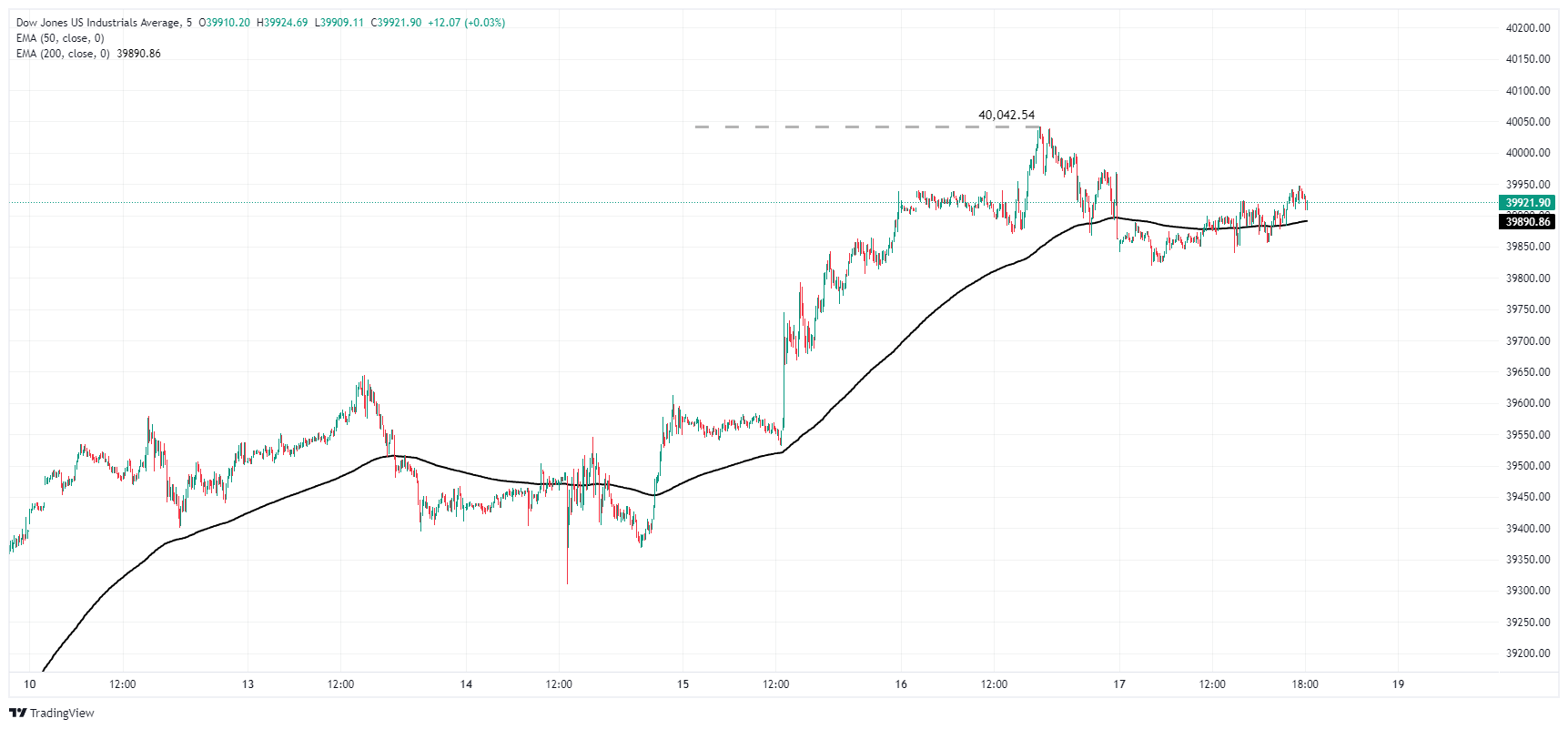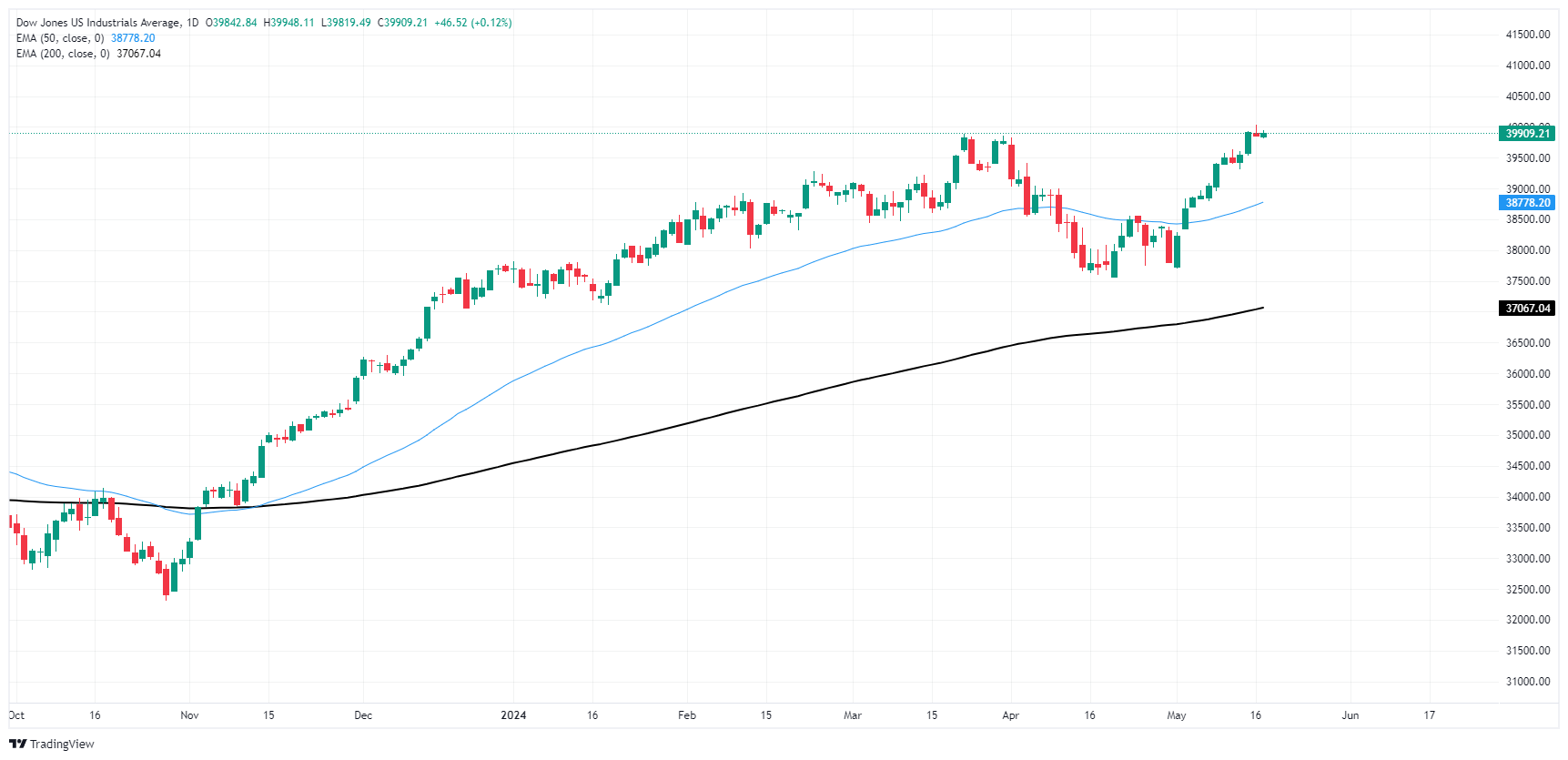- Phân tích
- Tin tức và các công cụ
- Tin tức thị trường
- Dow Jones Industrial Average adrift on quiet Friday volumes
Dow Jones Industrial Average adrift on quiet Friday volumes
- Dow Jones softly higher but still down slightly from recent record highs.
- Record equity gains on rate cut hopes could prove to be short-lived.
- Fedspeak remains key focal point for markets.
The Dow Jones Industrial Average (DJIA) is on the high side as markets wind down a hectic trading week that saw rate cut hopes return to the forefront after US Consumer Price Index (CPI) inflation eased to a three-month low. Easing inflation figures sparked a risk appetite rally that sent the Dow Jones over the 40,000.00 major price handle on Thursday as investors pin their hopes and dreams on the Federal Reserve (Fed) delivering at least two rate cuts before the end of the year.
Read more: Fed officials recognize overall inflation progress, but cautious tones remain
Despite easing inflation data this week, Fed officials have routinely talked down still-high market expectations. Fed Board of Governors member Michelle Bowman hit markets late in the Friday market session with cautionary comments highlighting that progress on inflation in 2024 has not been as good as many had hoped. Fed Governor Bowman also sees inflation remaining higher than markets expect, highlighting that further rate hikes are not off the table if inflationary pressures return to the data.
Dow Jones news
Despite record prints across the major US indexes, analysts have started to flash warnings signs that the record run-up in equities could lead to near-term volatility. According to Wells Fargo analyst Christopher Harvey, as quoted by CNBC Markets, investors should expect some choppiness in markets as the current investor narrative of bad news (easing economic conditions) meaning good news (rate cuts) could begin to unravel.
A little less than half of the 30 securities listed on the Dow Jones are lower on Friday, but losses are lean with the loss leader Intel Corp. (INTC) down -1.11% to $31.68 per share. Gainers are equally sedate heading into the trading week’s close, with Walmart Inc. (WMT), JPMorgan Chase & CO. (JPM), and Caterpillar Inc. (CAT) all up around 1% on the day.
Dow Jones technical outlook
The Dow Jones Industrial Average is trading on the low side of the 40,000.00 on Friday after Thursday’s record bidding action, but pullbacks remain limited and the major index is close to 39,900.00. The Dow Jones’ record high of 40,042.54 this week remains close by, and a technical floor is priced in above 39,800.00.
The Dow Jones is up over 1% for the week, and a bullish Friday close will mean the index has gained ground for all but two of the last 12 consecutive trading days. Bulls remain firmly in control with the DJIA trading well above the 200-day Exponential Moving Average (EMA) at 37,067.12.
Dow Jones five minute chart
Dow Jones daily chart
Fed FAQs
Monetary policy in the US is shaped by the Federal Reserve (Fed). The Fed has two mandates: to achieve price stability and foster full employment. Its primary tool to achieve these goals is by adjusting interest rates. When prices are rising too quickly and inflation is above the Fed’s 2% target, it raises interest rates, increasing borrowing costs throughout the economy. This results in a stronger US Dollar (USD) as it makes the US a more attractive place for international investors to park their money. When inflation falls below 2% or the Unemployment Rate is too high, the Fed may lower interest rates to encourage borrowing, which weighs on the Greenback.
The Federal Reserve (Fed) holds eight policy meetings a year, where the Federal Open Market Committee (FOMC) assesses economic conditions and makes monetary policy decisions. The FOMC is attended by twelve Fed officials – the seven members of the Board of Governors, the president of the Federal Reserve Bank of New York, and four of the remaining eleven regional Reserve Bank presidents, who serve one-year terms on a rotating basis.
In extreme situations, the Federal Reserve may resort to a policy named Quantitative Easing (QE). QE is the process by which the Fed substantially increases the flow of credit in a stuck financial system. It is a non-standard policy measure used during crises or when inflation is extremely low. It was the Fed’s weapon of choice during the Great Financial Crisis in 2008. It involves the Fed printing more Dollars and using them to buy high grade bonds from financial institutions. QE usually weakens the US Dollar.
Quantitative tightening (QT) is the reverse process of QE, whereby the Federal Reserve stops buying bonds from financial institutions and does not reinvest the principal from the bonds it holds maturing, to purchase new bonds. It is usually positive for the value of the US Dollar.
© 2000-2024. Bản quyền Teletrade.
Trang web này được quản lý bởi Teletrade D.J. LLC 2351 LLC 2022 (Euro House, Richmond Hill Road, Kingstown, VC0100, St. Vincent and the Grenadines).
Thông tin trên trang web không phải là cơ sở để đưa ra quyết định đầu tư và chỉ được cung cấp cho mục đích làm quen.
Giao dịch trên thị trường tài chính (đặc biệt là giao dịch sử dụng các công cụ biên) mở ra những cơ hội lớn và tạo điều kiện cho các nhà đầu tư sẵn sàng mạo hiểm để thu lợi nhuận, tuy nhiên nó mang trong mình nguy cơ rủi ro khá cao. Chính vì vậy trước khi tiến hành giao dịch cần phải xem xét mọi mặt vấn đề chấp nhận tiến hành giao dịch cụ thể xét theo quan điểm của nguồn lực tài chính sẵn có và mức độ am hiểu thị trường tài chính.
Sử dụng thông tin: sử dụng toàn bộ hay riêng biệt các dữ liệu trên trang web của công ty TeleTrade như một nguồn cung cấp thông tin nhất định. Việc sử dụng tư liệu từ trang web cần kèm theo liên kết đến trang teletrade.vn. Việc tự động thu thập số liệu cũng như thông tin từ trang web TeleTrade đều không được phép.
Xin vui lòng liên hệ với pr@teletrade.global nếu có câu hỏi.















